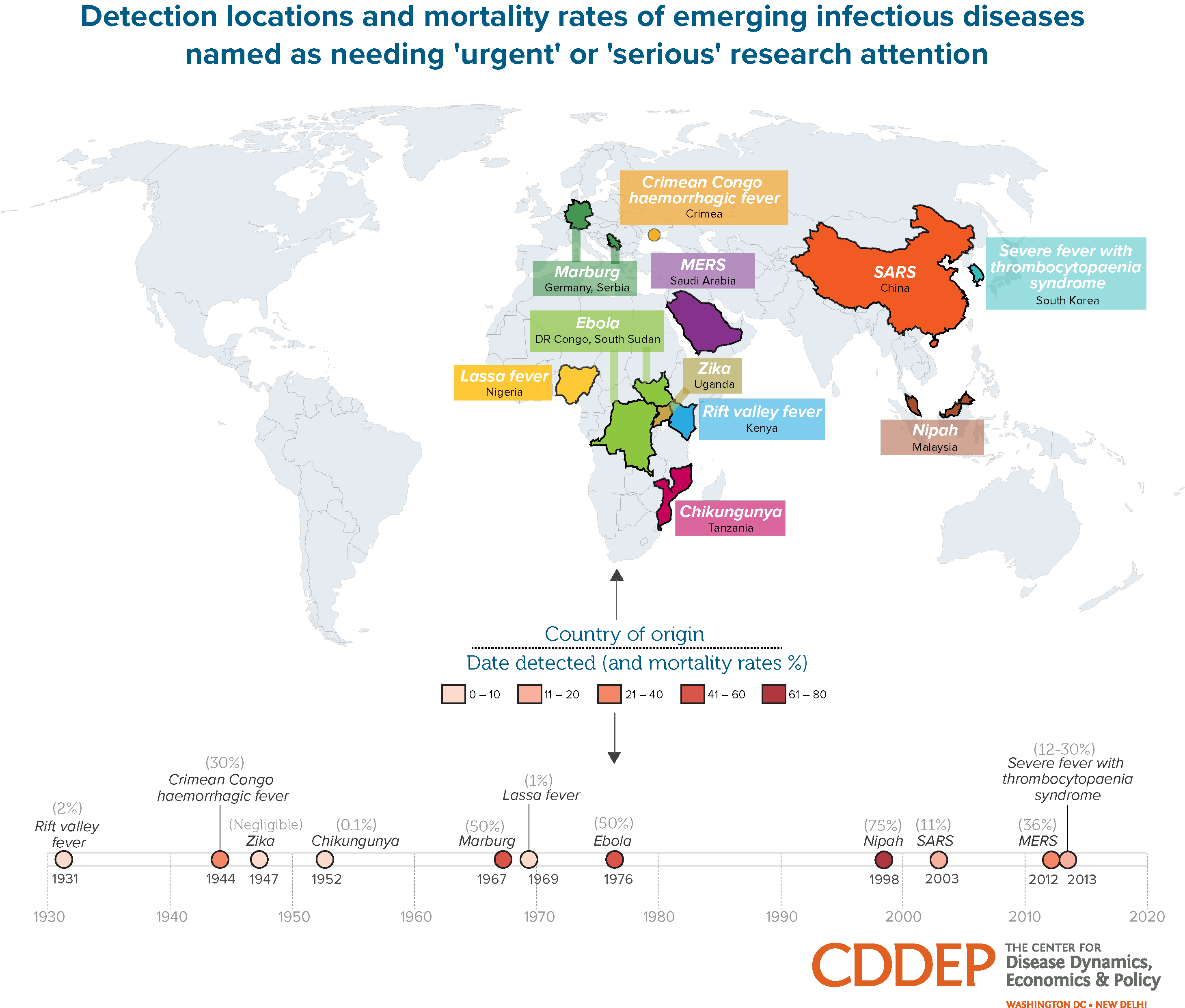August 05, 2016

Predicting the next global disease outbreak or pandemic is no easy task. In the absence of a crystal ball, the World Health Organization (WHO) convenes groups of experts in Geneva to advise on which emerging infectious diseases (EIDs) are likely to pose the greatest threats to humanity in the near future. Those pathogens identified are especially dangerous because they cause serious illness and few medical countermeasures exist to prevent or treat them. At the last meeting, in December 2015, 11 EIDs were named as needing “urgent” or “serious” research attention. These 11 diseases (in order of case volume) are:
- Chikungunya
- Lassa Fever
- Ebola Virus Disease
- Rift Valley Fever
- Zika
- Severe Acute Respiratory Syndrome
- Crimean Congo hemorrhagic fever
- Middle East Respiratory Syndrome
- Marburg
- Nipah Virus
- Severe fever with thrombocytopenia syndrome
These diseases are persistent concerns because they all have pandemic potential. However, they receive little funding, in part because they are not the most immediate threats. R&D spending for the 11 diseases on the 2015 list is about US$ 352 million every year, while malaria alone receives the equivalent of US$ 854 million [1, 2].
Lassa fever leads the list in both cases and death: more than nine million cases and more than 300,000 deaths in the last 40 years. Ebola comes in second, largely due to the epidemic that started in 2014. More than 28,000 cases and 11,000 deaths were recorded, with a case fatality rate of close to 50 percent. Although the WHO declared the Ebola emergency over, the affected countries of West Africa will be dealing with the after-effects for years to come [3]. These diseases have already caused noticeable amounts or mortality and morbidity, but both diseases, if not contained, could cause much more serious pandemics than they already have.
Zika is not as fierce a killer as Ebola and Lassa fever, but has serious chronic and generational effects [4]. Fewer than 10 deaths are recorded among the 1.5 million cases that have occurred since the detection of the disease in 1947. Chikungunya, another mosquito-borne disease, is similar—for the 1.7 million cases recorded, only about 1,700 deaths as a result of the virus have been recorded [5]. Zika virus has recently been associated with vertical transmission, resulting in newborn microcephaly, a severe neurological disease [4].
The most recently detected diseases on the WHO’s list have been identified within the last 15 years, and include severe acute respiratory syndrome (SARS), identified in China in 2003; Middle East respiratory syndrome (MERS), identified in Saudi Arabia in 2012; and severe fever with thrombocytopenia syndrome, identified in South Korea in 2013. The global health community still knows very little about these three diseases and more research on their pathogenicity and reservoirs is needed [6, 7, 8].
The global response to these diseases has, historically, been reactionary, not precautionary. The Ebola outbreak and the current Zika epidemic are just two recent examples. During the 2014 Ebola epidemic, funding increased dramatically from tens of millions of dollars to well over US$ 1 billion within months of WHO declaring the outbreak a “public health emergency of international concern.” [9]
We can learn from our reactionary responses and take the EIDs seriously by providing serious funding before they do us great harm. In addition to specific funding for these EIDs, investing in sound public health infrastructure, contingency planning, and robust surveillance will not only help to prevent outbreaks of these EIDs, but will aid in the primary and secondary prevention of current high-burden diseases. Containing and curing these diseases is a forward challenge that will not be reached without global cooperation and prioritization.
Kara Suvada is a Social Media and Data Visualization Intern at CDDEP.
Image via Yann (CC BY-SA 4.0)
Sources:
- Chuang, I., & Richie, T. L. (2012). World Malaria Report 2010: Documenting progress towards malaria eradication. Expert Review of Vaccines, 11(1), 39-41. doi:10.1586/erv.11.165
- The U.S. Government & Global Emerging Infectious Disease Preparedness and Response. (2008, December 08). Retrieved June 28, 2016, from http://kff.org/global-health-policy/fact-sheet/the-u-s-government-global-emerging-infectious-disease-preparedness-and-response/ –
- Outbreaks Chronology: Ebola Virus Disease. (2016, April 14). Retrieved June 28, 2016, from http://www.cdc.gov/vhf/ebola/outbreaks/history/chronology.html
- Cauchemez, S., Besnard, M., Bompard, P., Dub, T., Guillemette-Artur, P., Eyrolle-Guignot, D., Mallet, H. (2016, March 15). Association between Zika virus and microcephaly in French Polynesia, 2013–15: A retrospective study. The Lancet, 387(10033), 2125-2132. doi:10.1016/s0140-6736(16)00651-6
- Where Has Chikungunya Virus Been Found? (2016, May 12). Retrieved June 28, 2016, from https://www.cdc.gov/chikungunya/geo/index.html
- In the Absence of SARS-CoV Transmission Worldwide: Guidance for Surveillance, Clinical and Laboratory Evaluation, and Reporting. (2005, May 03). Retrieved June 28, 2016, from https://www.cdc.gov/sars/surveillance/absence.html
- Xie, Y., Lai, D., Liu, G., Zhou, J., & Lun, Z. (2015, February). Severe fever with thrombocytopenia syndrome in China. The Lancet Infectious Diseases, 15(2), 145. doi:10.1016/s1473-3099(14)70891-6
- Middle East Respiratory Syndrome (MERS). (2015, November 30). Retrieved June 28, 2016, from http://www.cdc.gov/features/novelcoronavirus/
- International donations to the Ebola virus outbreak: Too little, too late? (2015, February 05). Retrieved June 30, 2016, from https://saudeglobal.org/2015/02/05/international-donations-to-the-ebola-virus-outbreak-too-little-too-late/












